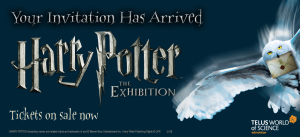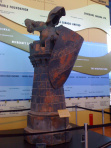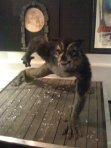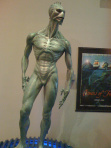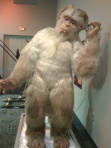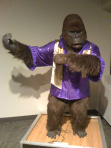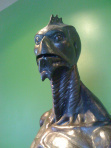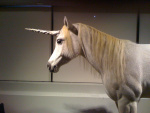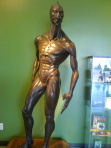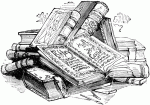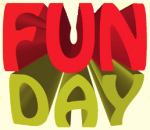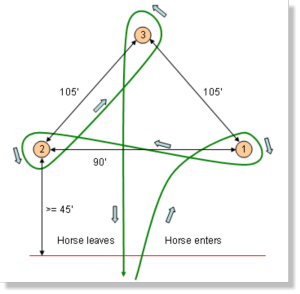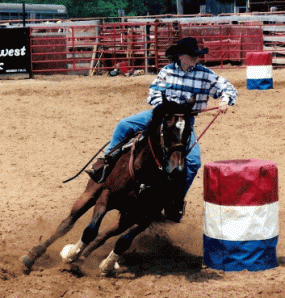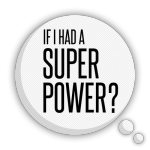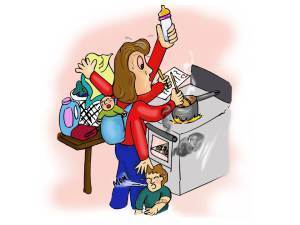Mandy Eve-Barnett's Blog, page 151
February 5, 2014
The Writing Process: Dialogue
After my last Writing Process post on characterization, someone requested that I write a post on dialogue. In the interest of helping out fellow writers, here's that post.
Dialogue is one of the fundamental elements of writing fiction. On a contextual level, dialogue is the method by which characters convey thoughts and feelings to one another. On a more abstract level, dialogue can be used to 1) define character personalities, 2) portray geographic location, culture, and character upbringing, 3) highlight important information, 4) balance out heavy narration, and 5) a thousand other things I can't think of off the top of my head.
Dialogue is a fundamental part of all narratives. Using it to good use and understanding how it moves the story along and gives our characters substance is worth studying.
The language used in our dialogue also plays an integral part in characterization. This link show a fascinating map of language in Europe.

February 4, 2014
Reincarnation – Fact or Fiction..?
February 3, 2014
Creating Monsters to Delight and Scare…
On Saturday, my daughter and I enjoyed the Harry Potter exhibition at a local venue. The props made for the movies are exquisitely detailed, in fact, a good deal of the hard work that went into producing them is totally missed when we view the movie. The costumes are elaborate and beautifully sewn, with textures and accessories unseen by audiences. Wands, books, jars and all manner of other props have been painstakingly created for visual effect but lost during the action of the characters. Unfortunately, photography was not allowed in the exhibition. However, this chess piece was displayed at the entry desk. An interactive ‘pulling up of a mandrake’ was a highlight of the exhibition. Hearing them squeal was fun. After exiting the exhibition it occurred to me that when we create characters and scenes in our narrative, we have to carefully balance the amount of detail we reveal. Too much or too little can lose the reader’s attention.
After the Harry Potter exhibit, we discovered another ‘bonus’ exhibition entitled ‘How to Make a Monster’. There were videos and partially formed figures detailing and showing, the process of creating a monster from drawing board to fully automated figure. The creators experimented with colors, textures and patterns to find the ‘right’ look for the creature they were building. This process is similar to our own character development. We pick their hair and eye color, their personality type and back story enabling us to write a complete character.
Monsters come in all shapes and sizes, human and beast. It takes skill and an understanding of how they think and react to situations that make them compelling. My vengeful witch in, The Rython Kingdom, was convinced she had the right to destroy for the imprisonment she had suffered. My Lord of the manor in, The Twesome Loop, thought his position entitled him to abuse those serving under him. Both characters are mean minded, evil and despicable, that is their attraction for our readers, who want to see them conquered.
A ‘monster’ in any guise has to be believable in the context of the narrative as well as have some sort of redeeming feature, no matter how small. A raging dinosaur might be protecting it’s eggs, any cornered animal will fight to survive, a serial killer has a compulsion or belief that their actions are permissible or they are driven to them. Take the TV show Dexter, he is a serial killer in disguise but still calmly kills people! His motive is to rid the world of murderers.
What is your most ‘evil’ character? What traits did you use to portray them?


January 31, 2014
Human Book Chains and Friday Fun…
The passion for books is not dead and this article proves it. If so many people are willing to brave the cold to physically pass thousands of books into a library, then we have hope that reading for gaining knowledge and for pure joy is alive and well. History is unfortunately littered with book burning’s for political and religious reasons but the human spirit and love of books has never been squashed.
When you realize how long the list is, then you understand books are more than paper sheets bound together - http://en.wikipedia.org/wiki/List_of_...
Saving them is paramount for future generations not just for historical reasons but for the author’s words to be shared and loved beyond their life. http://en.wikipedia.org/wiki/Book_bur...
“The people who stood in the Baltic Way remember that feeling of being shoulder to shoulder with complete strangers. The people taking part in the book chain who are prepared to stand here on a cold winter day are taking this seriously too – we are literally standing up for culture.”
Quotes: “A room without books is like a body without a soul.” ―Cicero
A personal favorite as an English woman: “You can never get a cup of tea large enough or a book long enough to suit me.” ― C.S. Lewis
And now for the fun part of today. A prompt to spark your imagination:
While hiking through a ancient woodland you discover a moss covered metal box with ornate brass decorations. What is inside? Where did it come from?
Share your responses.


January 29, 2014
Organize: 5 Ways in 15 Minutes a Day
 Reblogged from Peter D. Mallett:
Reblogged from Peter D. Mallett:






“Where did I put that editor’s phone number?”
Most creative types have some difficulty with organization. I’m no exception. Everyone misplaces their keys, but we seem to have a more difficult time with order. Surprisingly, we can be good at rearranging words, but poor at keeping track in other areas.
Over the years I’ve discovered this: Find what works for you.
Great tips for us to try...here was mine : http://mandyevebarnett.com/2013/08/11...
How to be Creatively Organized (Part 2)
 Reblogged from Peter D. Mallett:
Reblogged from Peter D. Mallett:





I won’t make the case for being over-the-top organized. I’m not, and I don’t think that I should change to be so. Trying would likely stress me out as much as my “mess” would stress out the person who is meticulously organized. However, I’ve talked to several writers, artists and creative people who want to improve in this area.
More thoughts on clearing your space
Why Creative People Need to be Organized (Part 1)
 Reblogged from Peter D. Mallett:
Reblogged from Peter D. Mallett:




Is organization the enemy of creativity? Is it true that analytical people excel at order and creative people don’t? Maybe; but there are several important reasons why you might need to learn some techniques for “getting it together” and even remembering where you put “it” afterwards.
1. Keep more of your money
Now that I have your attention, let me ask a few questions.
Options to consider as we plow through our writing life's clutter.
January 27, 2014
Learn To Take Turns…
The title says it all – learn to take turns – this is a barrel racing saying. One of many I learnt while researching my current WIP, Willow Tree Tears. It was certainly a journey into a world I had no previous knowledge of. Isn’t that what makes writing fiction all the more exciting?
The barrel racing course itself is a series of sharp turns in a clover-leaf shape, as you can see from the diagram below. A figure-eight pattern was the initial barrel racing circuit but has been replaced by the favored clover-leaf course, which demands a higher skill level. When watching these events I marveled at the synchronicity of horse and rider at speeds that were astonishing.
To begin a barrel race, the horse and rider enter the arena at top speed, through the center entrance. An electronic timer beam records the horse and rider as they cross it. This timer runs until the beam is crossed again at the end of the run.
Modern barrel-racing horses need to be fast, strong, agile and intelligent. To maneuver the course in as little distance as possible requires physical strength and agility from the horse as well as the ability to follow commands from the rider. Horses that can “hug the barrels” and maneuver the course quickly show up by their consistently low times. The favored breed for barrel racing is the American Quarter horse. The history of the breed began in the 17th century with British thoroughbreds paired with ‘native’ horses, (Chickasaw), which in turn were descended from horses brought over by the Conquistadors. Such as the Iberian, Arabian and Barb and wild horses.
The Girls Rodeo Association, (GRA) was the first organization specifically developed for women, who wanted to compete in rodeos. It was formed in 1948 by a group of Texan women consisting of only 74 members and having a limited 60 approved tour events. The group officially changed its name to the WPRA (Women’s Professional Rodeo Association) in 1981.
In 2013 the WPRA celebrated sixty five years of women in rodeo. The WPRA . . . the past, present, and future of women in rodeo!
Subsequent to writing my narrative, I found out a new ‘reality’ TV program is on air – Rodeo Girls. However, the authenticity of its portrayal of women in rodeo is open to discussion.
Why does every show have to glamorize and falsify ‘real’ life?
I read many derogatory comments on a forum once the show was aired from barrel racers appalled at the depiction of their profession. I am happy to declare my narrative is true to the real barrel racers and their lifestyle.
Willow Tree Tears is a romance which follows my protagonist, Trinity, a champion barrel racing young woman. Trinity must decide between two men. A man she has known since high school and who lives the ranching and rodeo life and a suave globe trotting Italian. She is determined and focused in her sport and lives on a Quarter horse stud with her father. Can she resist the lure of the unfamiliar? Is marrying her ‘kind’ best for her and her father’s hopes for her future and the ranch?
The launch of Willow Tree Tears is still under negotiation but I will announce it as soon as a date is finalized.
What have you learnt about through novel researching?


January 24, 2014
Are you Ready for Friday Fun and Literary News..?
Happy Friday!
We’ve managed another week…how was yours? Did you accomplish what you wanted or are the last few projects/things to do making it onto the top of next week’s list?
For many authors and writers the Amazon Breakthrough Novel Award announcement is exciting and nerve racking at the same time.
Should I enter? Is my novel ready? All submissions are a leap of faith and if nothing else good practice.
Are you entering? What is your genre?
This is the seventh year of this competition – make it your year.
http://www.amazon.com/Breakthrough-Novel-Award-Books/b?ie=UTF8&node=332264011
Fun Prompt:
You have a super power – what is it and how do you use it?


January 22, 2014
Juggling Family and Writing Commitments…
Many of us have to juggle family commitments while writing. Finding the ‘perfect’ balance between the two is always a challenge. You may be in the depths of a scene when a small hand lands on your lap and pleading eyes look up at you. Can you delay the toddler’s wants for your own? Do you crumble and leave the narrative in the hope you will remember the details later?
No matter what age your children are or how involved your partner, there is always a demand for your attention. There will be times when you just want to immerse yourself in your creativity, undisturbed. These three blog posts cover some of the emotions and stresses felt. As well as tips on how to organize your time productively.
http://thewriteconversation.blogspot.ca/2013/07/prioritiesjuggling-family-commitments.html
http://itsjustalittlething.wordpress.com/2013/10/22/on-fighting-sentiment
http://thewritersalleys.blogspot.ca/2010/06/juggling-summer-days-and-writing.html
How do you manage to juggle your family life and writing life?
As your children become older, is it easier?
Can you rely on a partner, friend or family member to entertain while you write?
What tips can you share?






